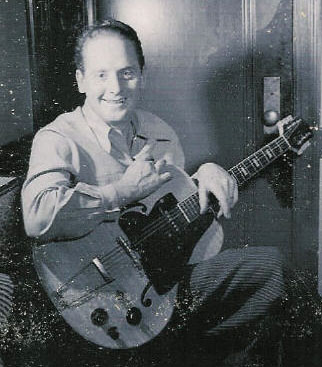| Les Paul  AKA Lester William Polfus AKA Lester William Polfus
Born: 9-Jun-1915
Birthplace: Waukesha, WI
Died: 13-Aug-2009
Location of death: White Plains, NY
Cause of death: Pneumonia
Remains: Buried, Prairie Home Cemetery, Waukesha, WI
Gender: Male
Race or Ethnicity: White
Sexual orientation: Straight
Occupation: Guitarist, Inventor Nationality: United States
Executive summary: Electric guitar/multitrack recording pioneer One of the most influential figures in the development of modern music-making, Les Paul developed an interest in both music and electronics very early in his life. At the age of nine he started teaching himself the guitar (having already tackled the harmonica and moved on from the piano and the banjo) and constructed his first crystal radio; within a year he had fabricated a primitive recording machine out of parts culled from a Cadillac and a dentist drill. By 13 he was performing semi-professionally as a country musician and began pursuing experiments to electrically amplify his instrument. Initial attempts involved the use of a record player needle, the earpiece from a telephone, and cannibalized radio components. Years later, the system was perfected with the replacement of the hollow guitar body with a solid block of wood: one of the earliest designs for what eventually came to be known as the solidbody electric guitar.
During his high school years Paul became a member of Rube Tronson's Cowboys, and shortly afterwards dropped out to work full-time with Wolverton's Radio Band on radio station KMOX in St. Louis. By the 1930s he had relocated to Chicago, where he began his recording career using the hillbilly persona of 'Rhubarb Red', maintaining at the same time a parallel career in jazz as Les Paul. His first trio was assembled in 1937, but the following year he moved to New York to work as a featured player on the radio broadcasts of Fred Waring's Pennsylvanians -- a job that was brought to an abrupt end in 1941 when he was nearly electrocuted during a session in his basement. On a more positive note, 1941 also saw the creation of the "The Log", the culmination of his efforts to create an electric guitar. The formation of a new trio and another change in his base in operations (this time to Los Angeles) and had taken place by 1943, the latter resulting in a fortuitous, last-minute enlistment as guitarist for the first of the Jazz at the Philharmonic events in 1944.
While in Los Angeles Les Paul began his association with Bing Crosby, who not only featured Paul and his trio on his radio program and several of his records, but also became one of the key supporters of the guitarist's experiments in recording technology. Having come into the possession of a captured German tape recorder, Paul quickly elaborated on the basic design and created a device that allowed him to layer (multitrack) parts; the first public result was the complex, eight-guitar piece Lover, released by Capitol Records in 1947. The subsequent popularity of the song added considerable momentum to his career, but a serious car accident not long afterwards very nearly brought it to a permanent end: a year-and-a-half was required to fully recover from the ordeal, and even then Paul was only able to continue his work because he had convinced his doctors to set his shattered right arm in a guitar-playing position.
In the 1950s a return to action was made through his collaborations with singer Colleen Summers, whom he had given the stage name Mary Ford and married in 1949. Utilizing a groundbreaking 8-track home studio system to layer Ford's vocals as well as his guitar, the two recorded a series of top ten singles across the next five years, some of the best-remembered being How High The Moon, Mockin' Bird Hill and Tiger Rag. A television showcase, The Les Paul and Mary Ford at Home Show, ran between 1953 and 1960. By 1950 Paul had also secured a deal with Gibson to market the "Les Paul" model solidbody electric guitar; the guitarist had approached the company much earlier after the refinement of his "Log", but shrewd business minds resisted the idea until it became clear that it was a commercially viable 'product'. The first Gibson Les Paul was made publicly available in 1952.
After his divorce from Ford in 1963, Les Paul largely retired from recording, occasional exceptions including Les Paul Now! in 1968 and a pair of collaborative records with Chet Atkins, Chester & Lester (1976) and Guitar Monsters (1978). In 1984 he once again resurrected his trio and initiated a weekly showcase at Fat Tuesday's in New York City, which endured until 1996 when the hosting venue was moved to the Iridium Jazz Club. The performances at Iridium continued until near his death, regularly featuring well-known guests from the different generations of musicians that benefited from his innovations and influence. Father: George Polsfuss (later Polfus)
Mother: Evelyn Stutz
Wife: Virginia Webb (div. 1949)
Son: Les Paul, Jr. ("Rusty", b. 1941)
Son: Gene (b. 1944)
Wife: Mary Ford ("Colleen Summers", m. 1949, div. 1963)
Daughter: Mary Colleen (adopted, b. 1958)
Son: Robert (b. 1959)
Tau Kappa Epsilon Fraternity
Grammy 1976 (country instrumental performance, with Chet Atkins)
Grammy 1979 (Hall of Fame, with Mary Ford)
Grammy 2001 (tech award)
Grammy 2006 for Les Paul & Friends: American Made World Played
National Inventors Hall of Fame
Rock and Roll Hall of Fame 1988
National Humanities Medal 2007
National Medal of Arts 2007
Heart Bypass Operation quadruple (1980)
Endorsement of Coors 1998
Risk Factors: Arthritis
FILMOGRAPHY AS ACTOR
The Dream Catcher (8-Aug-1999)
Sensations of 1945 (30-Jun-1944) · Himself
Requires Flash 7+ and Javascript.
Do you know something we don't?
Submit a correction or make a comment about this profile
Copyright ©2019 Soylent Communications
|